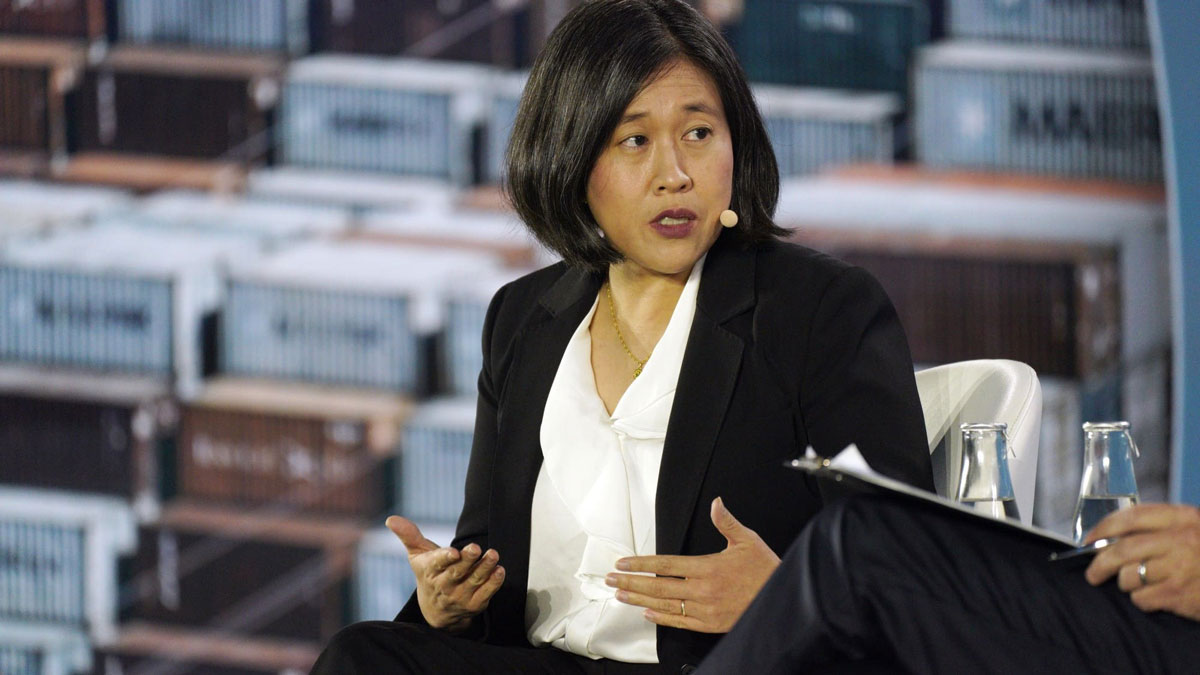While most of the news from the World Trade Organization (WTO) has been gloomy, Friday saw a rare breakthrough. More than 80 members of the group working on digital trade reached an historic agreement, albeit with an awkward phrasing. Leaders released a "stabilized text" for the Joint Statement Initiative (JSI) on Electronic Commerce.1
This is not the sort of language that makes anyone outside policy circles stand up and take notice, but it profoundly matters. Digital is the future of trade.
This agreement represents the first time the global trade body, absent the United States, has managed to draft digital rules. JSI members range from advanced economies to least developed economies and the final stabilized text was acceptable for heavyweight members from China and the European Union to smaller ones like Benin and Laos.2 Given the difficulties that the WTO has had in reaching consensus, it is a rare opportunity to celebrate this negotiating success.
It took five years to get to this point. Originally launched in late 2017, the JSI was an attempt to get as many members as possible to work on a critically important trade issue that was otherwise stuck. An ongoing e-commerce work program from 1998 had barely budged, leading about 70 members, led by Australia, Japan, and Singapore, to try a different route. This JSI process currently includes 91 members, although not all have approved the stabilized text.
The WTO does not have rules that explicitly cover digital trade. The JSI text, by contrast, covers six areas: enabling electronic commerce; openness; trust; transparency, cooperation and development; telecommunications; and exceptions.3
This coverage broadly mirrors digital trade commitments that some JSI members have made in other bilateral and regional trade agreements. The potential application of consistent rules to manage digital trade across more than half of the WTO members is critically important. The digital economy does not fit easily within geographic boundaries. A company in one location can quite easily use digital tools to buy and sell goods and services anywhere else in the world.
While governments were once content to allow digital trade to flourish with limited rules in place, this situation is changing rapidly. Inconsistencies in regulations can make it difficult, expensive, or simply impossible for trade flows to continue. Growing regulatory and legal fragmentation harms smallest firms the most, as they have the fewest resources to manage diverse business environments.
This is why the release of the stabilized text should be met with an enthusiastic cheer, even if the final outcome does not contain everything that might have been objectively desirable. The text is full of "shall endeavour" commitments which can make it hard to determine exactly what might (or might not) be on offer from any member. Still, consistent "endeavoring" should be better than having no alignment at all on digital rules and regulations.
Early reviews of the text have largely focused on five issues:
- a JSI text that is about rules and does not have market access schedules;
- an insufficient commitment to data movement and data hosting requirements;
- ambiguous wording about making the customs moratorium permanent;
- a final text that does not include all members of the JSI; and
- a lack of clarity on the way that this text will be incorporated into the WTO.
First, the focus in the early stages of the JSI negotiations included both the expansion of trade rules to explicitly cover digital issues and the creation of specific market access commitments or schedules. This is especially important as existing schedules, such as for services sectors, may be read as extending to include digital services trade. But, equally plausibly, existing schedules may not clearly include digitally delivered services.
There was scope, therefore, for negotiations to adjust existing schedules or to negotiate new schedules related to the JSI. However, the stabilized text has dropped references to potential schedules or market access, focusing instead on the crafting of rules for digital trade.
Of course, having consistent rules across more than 80 WTO members is extremely important. The Organisation for Economic Co-operation and Development has estimated that digital trade already accounted for a quarter of global trade flows in 2020, worth an estimated US$5 trillion.4 The JSI, even without explicit market access commitments, should accelerate this growth.
Second, many early commentators have examined the texts and noted problems related to the cross-border movement of data and data hosting requirements. This is not a surprising outcome, as the United States withdrew its support for these issues in October 2023.5 The stabilized text does not even contain a reference to allowing cross-border data flows or have an article on data hosting. These are common provisions in other digital trade agreements, including the five different digital-only agreements that Singapore, one of the three co-convenors of the WTO’s ‘stabilized text’ deal, has already concluded.6
Perhaps more problematic, the list of permitted exceptions is lengthy, with one in particular, Article 25, providing a significant loophole on the movement of personal data across borders. However, given the lack of support by the United States for the WTO deal and a range of extant divergent views on the regulation of personal data and privacy among jurisdictions from China to the European Union, it was never going to be easy to bridge these gaps.
Third, a key request from businesses for the JSI from the outset was to make the customs moratorium on electronic transmissions permanent. We have examined this issue extensively in the past.7 For now, simply note that the text does not clearly provide for a permanent extension of the moratorium. The general WTO membership has extended the moratorium through the next Ministerial Conference, but businesses were looking to the JSI to make the moratorium permanent. Instead, the text provides for a review after five years. This review could be a simple look or it may not.8
Fourth, an early area of focus has been on the membership. Brazil, Colombia, El Salvador, Guatemala, Indonesia, Paraguay, Taiwan, Türkiye, and the US are not listed as sponsors of the released text. This does not mean, it should be noted, that these WTO members will never become full JSI participants, but they are not currently on board. Indonesia, for example, has apparently not yet decided if the moratorium language in the JSI is acceptable domestically.
There has been a lot of early dismay that the United States was not able or willing to sign on to the stabilized text. There has been some suggestion that the release of the text could have been delayed until after the US election in November to give the US more of an opportunity to sign on to the deal. However, at this point there is little indication that either candidate in the US presidential election is prepared to make digital trade or, indeed, the WTO a priority in the near term. The JSI co-conveners appear to have decided that holding the entire text at bay on the off-chance that a new US presidential term would allow greater flexibility by the Americans was a poor bet.
Finally, a legal issue of weaving the latest JSI agreement into the WTO architecture of rules: although there has been relatively muted early attention to the vexing issue of incorporation, the WTO has not had a lot of success lately in getting commitments in the various plurilateral agreements added to the overall set of legal commitments.9 Another JSI, on investment facilitation, for instance, had a fourth attempt at inclusion fail in July.10 Unless and until the JSI rules are incorporated into the WTO, including with greater clarity on whether the provisions apply to non-members, the agreement will provide only weak guidance towards future digital policy alignment.
It may seem, then, that the JSI is not a terribly useful agreement, given the assessments from early commentary. But these issues should not determine the true utility of this agreement. As digital trade continues to spread and become the dominant form of trade, the risk of regulatory fragmentation has only increased. The JSI provides a common platform – perhaps soon a de facto global standard – for more than 80 countries to better insure regulatory consistency.
If trade is to work for most, digital trade rules are critically important frameworks. It is especially notable for smaller firms that are least able to manage inconsistent rules. The release of a stabilized text is therefore a welcome addition to the WTO and global trade agenda.
***
[1] There is a note in the stabilized text to say that further negotiations may still take place, leading to the potential inclusion of topics that had been on the negotiating table including scope, exceptions, and dispute settlement.
[2] 86 JSI members are (currently) included in the stabilized text, with 11 participants withholding approval. See Joint statement initiative on E-commerce
[3] Joint statement initiative on electronic commerce
[4] See, for example, Digital trade and Of bytes and trade: Quantifying the impact of digitalisation on trade
[5] In particular, see Why does the US hate digital trade? and International Economic Law and Policy Blog: The U.S. Changes Its Mind in the WTO E-Commerce Negotiations.
[6] Singapore has digital rules in ASEAN’s 2018 E-Commerce Agreement, in ASEAN-Australia-New Zealand FTA (AANZFTA), the Comprehensive and Progressive Trans-Pacific Partnership (CPTPP), the Regional Comprehensive Economic Partnership (RCEP), the Digital Economy Partnership Agreement (DEPA), and four bilateral Digital Economy Agreements (DEAs) with Australia, the United Kingdom, South Korea and now the European Union.
[7] See E-commerce deal at the WTO is suddenly back in play and Prepare to pay more for digital services.
[8] The review clause (11.5) says members will examine the impact of the provision and whether adjustments are appropriate.
[9] See the paper on plurilateral versus multilateral trade agreements at The challenge of getting to yes at the WTO.
[10] 125 WTO members fail at 4th attempt to formalise plurilateral investment deal.
© The Hinrich Foundation. See our website Terms and conditions for our copyright and reprint policy. All statements of fact and the views, conclusions and recommendations expressed in this publication are the sole responsibility of the author(s).






